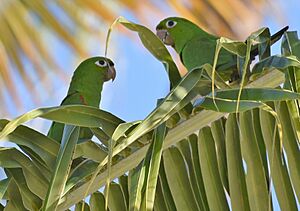Hispaniolan parakeet facts for kids
Quick facts for kids Hispaniolan parakeet |
|
|---|---|
 |
|
| Conservation status | |
| Scientific classification | |
| Genus: |
Psittacara
|
| Species: |
chloropterus
|
 |
|
The Hispaniolan parakeet (Psittacara chloropterus) is a type of bird found only on the island of Hispaniola. This island is shared by the Dominican Republic and Haiti. People in the Dominican Republic call it "perico," and in Haiti, it's known as "perruche." It is a Vulnerable species, meaning it needs our help to survive.
Contents
About the Hispaniolan Parakeet
Scientists used to call the Hispaniolan parakeet by a different scientific name. Now, they agree it belongs to the group of birds called Psittacara. Some scientists once thought the Puerto Rican parakeet was the same kind of bird. However, the Puerto Rican parakeet is now extinct. It used to live on Mona Island and possibly Puerto Rico itself.
What Does It Look Like?
The Hispaniolan parakeet is about 30 to 33 cm (12 to 13 in) long. It weighs around 144 to 147 grams (5.1 to 5.2 oz). Both male and female parakeets look alike. They are mostly green, with their bellies being a bit more yellowish. Some birds might have a few red spots on their heads.
The bend and edge of their wings are red. The feathers under their wings are also red. The undersides of their flight and tail feathers are a dull yellowish color. They have bare white skin around their eyes. Young parakeets have very little or no red on their wings.
Where Do They Live?
The Hispaniolan parakeet used to live all over the island of Hispaniola. Today, in the Dominican Republic, you can mostly find them in the Cordillera Central and Sierra de Bahoruco mountains. They also live in some cities. In Haiti, they are very rare. They have been seen in the Chaîne de la Selle and Massif de la Hotte areas.
These parakeets live in many different places. They can be found in lowland and mountain forests. They also live in savannas, open woodlands, and even farmlands. You might even spot them in cities like Santo Domingo. They are most common in humid mountain forests. They can live from sea level up to 3,000 meters (9,800 ft) high.
Behavior and Habits
Movement
The Hispaniolan parakeet does not migrate. This means they stay in the same area all year round.
Feeding Habits
We don't know everything about what the Hispaniolan parakeet eats. We do know they enjoy eating fig fruits. They are also reported to eat fruits, seeds, and flowers from many other plants and trees. Sometimes, they are seen eating maize (corn) crops.
Reproduction
The Hispaniolan parakeet builds its nests in holes in trees. They also nest in the large, hard nests built by termites on trees. We don't know much about how they reproduce in the wild. When they are kept in captivity, females lay three or four eggs. The eggs hatch after 20 to 23 days. The young birds are ready to fly after about eight weeks.
Vocalization
The Hispaniolan parakeet makes a "kree" sound. This call has a rough, noisy quality. They make this sound both when they are flying and when they are sitting still.
Status and Threats
The Hispaniolan parakeet is listed as a Vulnerable species. This means their population is decreasing. Their home range is small and broken up into many pieces. Scientists believe there are only about 1,500 to 7,000 adult birds left.
The main reasons for their decline are habitat loss and being hunted. People sometimes hunt them because they eat crops like corn. Another big problem is illegal trapping. People catch them to sell as pets, both within the country and to other countries.


